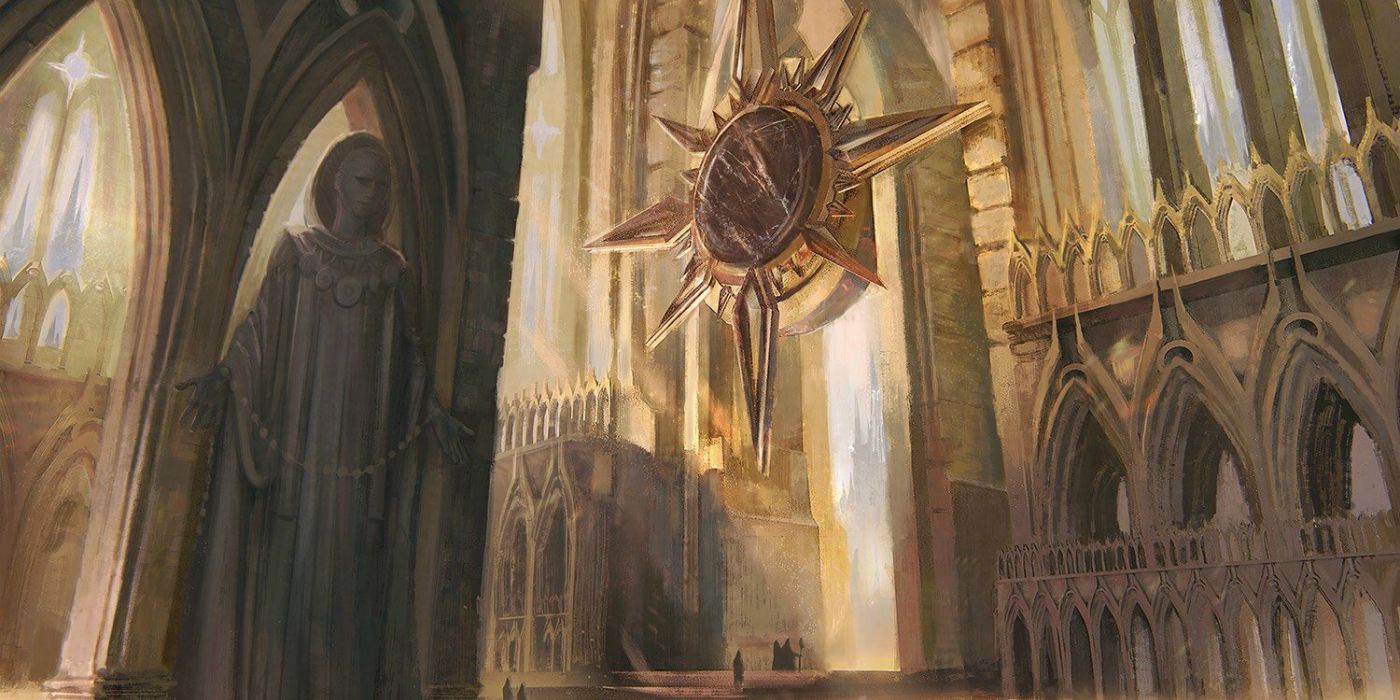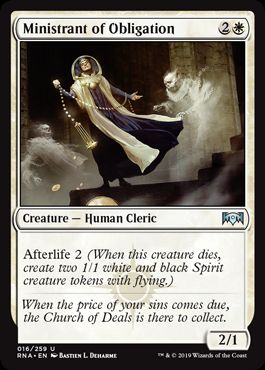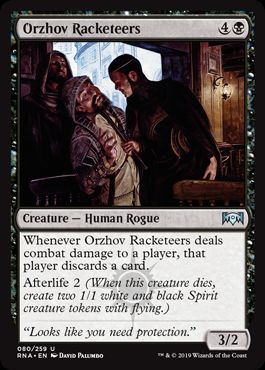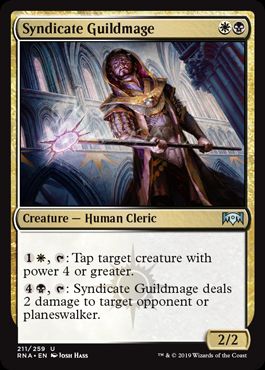Magic: The Gathering's newest Standard set is just weeks away from its release, and Ravnica Allegiance is sure to shake up one of the game's most popular formats. Thanks to the success of Magic: Arena, Standard has continued to play a larger part in the way players approach competitive Magic. Everyone's looking for an edge heading into a brand new season with hundreds of new, powerful cards, and one of the biggest ones to be gained is simply knowledge of the card pool.
That's where our previews come in. Screen Rant was lucky enough to be given three preview cards from Wizards of the Coast, and they all deal with one of the five guilds that will be introduced as part of Ravnica Allegiance. The Orzhov are like the exploitative capitalists of Ravnica, creating complicated systems of debt that see citizens paying off what they owe well after they have passed on. Orzhov cards are typically designed to reflect their constant desire to create and proliferate debt, and their cards in Ravnica Allegiance are no different. Their new keyword mechanic, Afterlife, populates the battlefield with 1/1 flying Spirits whenever the creature that has Afterlife dies, showcasing how one is never truly free from their obligation to the Orzhov. Gavin Verhey, Senior Designer for Magic: The Gathering, shared some insight into how Orzhov was designed in the upcoming set:
"Orzhov are the white-black guild on Ravnica, making crooked deals and drawing people into debts. Death has never stopped people from replaying those debts either. Combine that with the fact that black and white are both colors that love to create tokens and you get Afterlife!
Afterlife is a brand new mechanic for the Orzhov. When a creature with Afterlife dies, you get some number of spirit tokens afterward. This plays very well into the token strategies black and white often deploy, which tend to be resilient. That’s certainly the case for cards with Afterlife: these cards still provide value when trading in combat or dying to removal spells by leaving another creature behind. This also opens up cool synergies with cards which give allow you to sacrifice your own creatures or sacrificing tokens for a benefit."
Related: Magic Arena Will Eventually Have A "Standard Plus" Format
Afterlife is the kind of mechanic that is immensely powerful on the right cards. Having to use a card to kill an opponent's creature only for that creature to replace itself is card disadvantage - a few exchanges like that and you'll suddenly be wondering where all your cards went as an army of Spirits attacks each turn. Afterlife is even more interesting because it can create more than one Spirit in the right scenario. Just take a look at our first preview card here:
Afterlife 2 on a 3 mana creature! Okay - at first glance, the rate on Ministrant of Obligation doesn't seem exceptional. Paying 3 mana for a 2/1 is a quick way to fall behind if that card doesn't impact the battlefield. Luckily, Ministrant of Obligation is positioned to do exactly that. Ministrant of Obligation could genuinely see constructed play in decks that care about making early trades, creating Spirit tokens, or sacrificing creatures to gain powerful abilities. While Ministrant of Obligation isn't going to set the Standard world ablaze, it's the kind of card that can certainly be more impactful than people give it credit for in preview season. If there's a deck that wants to use Gruesome Menagerie to recur sacrifice targets, Ministrant of Obligation fills the three-drop slot for that quite admirably.
In Limited, Ministrant of Obligation will be a top-tier uncommon. It's hard to imagine a world in which the card fulfils any other role. The rate on Ministrant of Obligation in a format that's as resource-hungry as Limited is just insane. Even in the "worst" scenario where an opponent has no creatures who outright die to a Ministrant of Obligation block, it will threaten to chump and produce two fliers that can swing a race or attack every turn, forcing an opponent to decide when to deal with it and the fliers it produces after it dies. That's roughly the floor for Ministrant, but the ceiling is much higher. Any time this card trades with an opponent's two or three mana creature, it will immediately produce a resource exchange that favors its controller heavily.
Orzhov Racketeers, on the other hand, is probably never going to see Standard play, and that's okay. If every uncommon was a Standard playable, the set would be way too powerful. A 5 mana investment for a 3/2 that has to deal damage to a player to do anything is rough - even factoring in Afterlife 2, it's arguable whether or not the 5 mana is even breaking even after the 1/1 Spirits enter play. Perhaps there will be a roleplayer slot for this card somewhere, but as it stands, there are too many cards that can outright win a game for cheaper in Standard right now - think Crackling Drake, History of Benalia, and Rekindling Phoenix, for starters.
In Limited, Orzhov Racketeers has some real potential. It's going to be a legitimate threat in matchups where both players have slow decks and few creatures. If Racketeers connects once before it dies, it has already generated a massive advantage thanks to Afterlife 2. Racketeers will be at the mercy of how the overall Limited format in Ravnica Allegiance looks. If it ends up fast, this card will probably be too slow to make a big impact on it. If the format is slower, though, Orzhov Racketeers could surprise everyone.
One card that, based on its cycle, has historical precedent for being strong in Limited is the newest Guildmage to grace the Orzhov. While it might not have much to do with the afterlife, Syndicate Guildmage will feel right at home in any Orzhov deck:
If the abilities on Syndicate Guildmage look a little weird, that's because they are. Typically, the Guildmages represent effects that are associated with their guilds. Syndicate Guildmage doesn't synergize with Afterlife at all, and also doesn't continue the long history of the Orzhov and lifelink or drain (causing an opponent to lose life and gaining life equal to the amount lost) effects.
With that said, though, Syndicate Guildmage is still an extremely powerful card in Limited, which is where the Guildmages tend to shine. Syndicate Guildmage is a 2/2 body early, has the ability to tap down your opponent's biggest threats late game, and can also grind a game out if both players are stalling thanks to its second ability. That kind of flexibility - being good early, mid, and late game - is the hallmark of a high draft pick in Limited. In Standard, games are often more about using your mana efficiently every turn, which Syndicate Guildmage does not do particularly well. Expect to see a lot of the Guildmage in Limited and be pleasantly surprised when you see someone who found a use for this powerful card in Standard.
Looking at these three Orzhov uncommons from Ravnica Allegiance, it seems pretty clear that the Church of Deals is a good place to be when the set releases on January 25, 2019. Will you sell your soul to the Orzhov in exchange for power? We have to admit, it's a pretty tempting offer.




